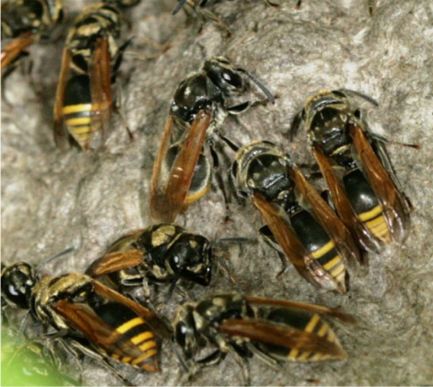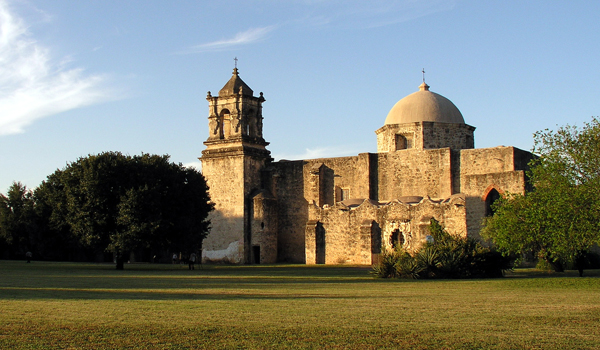- La Feria Community Holds Succesful Business Mixer Event
- Little Nashville to Take Place in Downtown Mercedes
- Lions Basketball Captures District Gold
- La Feria ISD Students Compete in Regional Chess Tournament
- Lions End First Half of 32-4A on a High Note
- La Feria ISD Held Another Successful Parent Conference
- Strong Appearance for Lions at Hidalgo Power Meet
- LFECHS Students Get to Meet Local Actress
- Students Participate in Marine Biology Camp
- Two LFECHS Students Qualify for All-State Band
We’re not bees, if you please…
- Updated: April 29, 2013
Large paper nests in South Central Texas trees most likely home to honey wasps

Workers are mild mannered by vespid wasp standards but sting hard when sufficiently provoked. Photo: http://www.texasento.net/Brachygastra.htm
SAN ANTONIO – If there’s a large, gray ball-shaped nest in your tree, the insects inside likely aren’t bees but Mexican honey wasps, according to a Texas A&M AgriLife Extension Service entomologist in San Antonio.
“I’ve been getting a lot more calls than normal from people throughout Bexar County saying they’re finding large round nests in trees on their property,” said Molly Keck, AgriLife Extension integrated pest management specialist for Bexar County. “They’re worried they have bees nesting in their trees, but these are probably honey wasps. These wasps are smaller than bees – about the same size as a housefly — and are non-aggressive.”
These wasps can easily be distinguished from bees, Keck said.
“They’re not hairy like bees,” she said, “and in addition to being much smaller, honey wasps are nearly all black and don’t have any of the typical bee markings.”
Keck said the Mexican honey wasp, Brachygastra mellifica, is a social species that builds paper nests in the canopies of trees and shrubs.
“By contrast, honey bees in the wild tend to colonize more in the cavities of large trees or openings in walls or overhangs as opposed to building nests in trees,” Keck noted.
While there are 16 different species of Mexican honey wasps, only one species has been reported in Texas, she said.
“However, in addition to the south and south-central portion of Texas, they’re found throughout Mexico and Central America,” she said.
Honey wasp colonies can become quite large, with some containing several thousand wasps, Keck said.
“It can cause concern when people see a large basketball- or football-shaped nest attached to the branches of a tree or shrub,” she said. “But these wasps typically live peacefully with their human neighbors. However, if you climb into the tree or throw rocks at the nest or squirt it with water or do something else disruptive, the wasps will become irritated and that will increase your chance of being stung.”
Keck said walking past a tree harboring a wasp nest, mowing the lawn, closing a car door or going about regular outdoor activities will largely go unnoticed by the wasps.
“Mexican honey wasps are considered beneficial insects, much like honey bees,” she said. “They are nectar gatherers, pollinators, and have been known to predate on harmful insects such as the Asian citrus psyllid, which has been identified as a vector for citrus greening disease.”
Recently, a small team of researchers from London led by Dr. Ellouise Leadbeater, a research fellow from the Institute of Zoology, Zoological Society of London, came to the Lower Rio Grande Valley and South Central Texas to study honey wasps. Leadbeater and her team were headquartered at the Texas A&M AgriLife Research and Extension Center in Uvalde.
“We were interested in studying honey wasps as they are the only wasp to produce honey on a large scale and are a distant relative of the honey bee,” she said.
“We had put out the word that we wanted to do this research, and got our best response from the Uvalde center.”
Leadbeater said she is investigating the genetic makeup of the honey wasp to see if the genes that make this species behave the way it does are the same or similar to genes that influence the behavior of the honey bee.
“Understanding similarities in the genetics of the two species could help provide insights into how changes to one species would likely affect the other,” she said. “For example, if someone is developing a pesticide they want to be sure doesn’t negatively affect honey-bee populations, knowing that the geneticmakeup of honey wasps is similar would help them determine whether it would have a similar effect on those populations as well.”
So far, Leadbeater and her team have investigated about 10 honey wasp nests in South Central Texas, located with the help of sighting reports from the Uvalde center. The center received 40-50 calls from people who had nests matching the features of honey wasp nests on their property.
“Some of the nests were inaccessible or we didn’t have time to find them,” Leadbeater said. “The largest nest we found was off Interstate 37 between the Lower Rio Grande Valley and Corpus Christi. We estimated a population of about 20,000 for that one.”
While Leadbeater will soon return to London to examine the wasps and determine their genetic makeup, two members of her team will remain at the Uvalde center for another month to continue their research.
“This is an active time for both honey wasps and honey bees,” said Keck. “And because now is the beginning of what entomologists call ‘bee swarm season,’ South Central Texas residents can expect even more activity in the coming months.”
However, she added, the advice is essentially the same for avoiding both bee and honey wasp stings.
“If you leave them alone and don’t antagonize them, they’ll pretty much do the same for you.”





One Comment